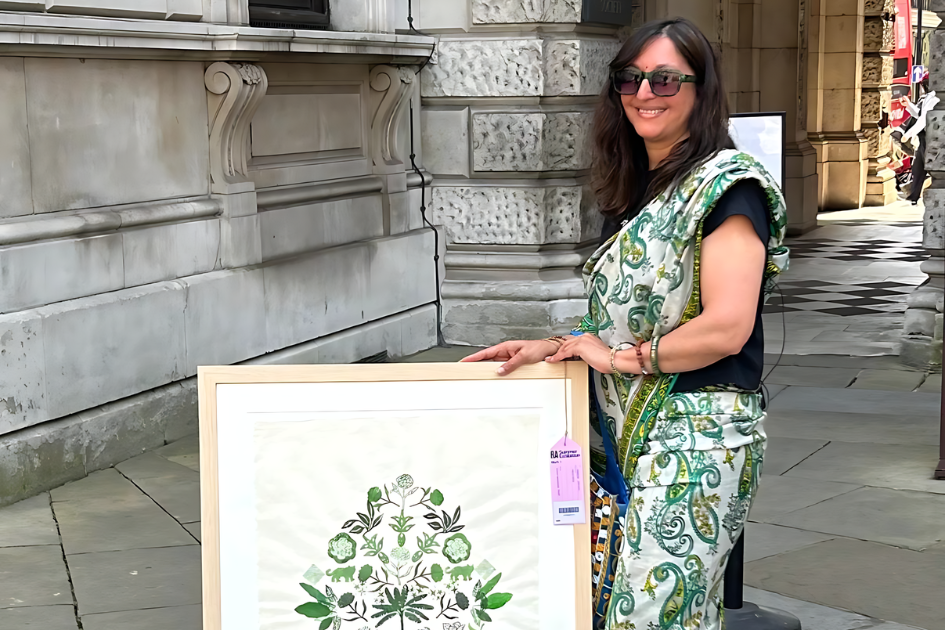Interview with local artist Neera Sehgal

Meet Neera Sehgal, an Ealing-based artist whose work explores the intricate layering of patterns and images using Indian woodblocks. This process, rooted in tradition yet reimagined beyond its textile origins, becomes a meditative practice for Neera. She collaborates with skilled artisans in India who carve her designs, creating a bridge between cultures and generations that deeply connects her to her heritage. Since discovering printmaking in 2017, Neera has shared her passion through workshops and has showcased her art at notable venues, including the Royal Academy Summer Exhibition 2024. I spoke to her and discussed her creative process, the meditative nature of her work, and the honour of exhibiting at the Royal Academy.
Your work involves a unique collaboration between cultures and generations, especially with the Indian craftspeople who carve your woodblocks. Can you share more about how this collaborative process influences your artistic vision and the final pieces?
Collaborating with Indian artisans is fundamental to my printmaking process. I begin by sketching designs, which are then intricately carved into woodblocks by skilled craftspeople in Jaipur, India. These artisans have honed their craft over generations. Growing up surrounded by block-printed fabrics, I have a deep personal connection to this art form. The woodblocks evoke a sense of nostalgia and warmth, influencing my work and helping me stay connected to my heritage. I primarily use handmade paper and employ both traditional and contemporary block designs, creating fresh, unique pieces that celebrate and honor their cultural roots.
You've mentioned that the process of mark making with Indian woodblocks is meditative for you. Can you elaborate on how this meditative practice impacts your creative process and the themes you explore in your work?
Before starting a composition, I spend time engaging in print play with my selected blocks and inks. This preparation is akin to a musician tuning their instrument before a performance. Once I begin printing, I enter a rhythmic state where it’s just me, the ink, and the blocks. This repetitive motion is calming, allowing my mind to wander and my creativity to flow freely. Often, the final outcome diverges from my initial vision, which I embrace as a liberating aspect of my creative process.
My piece for the Royal Academy, ‘Meditate,’ delves into the theme of ‘making space’ for the Summer Exhibition. It reflects on my childhood home, ‘Round Coppice’ in Rickmansworth, which was a personal haven. After my parents passed away two years ago, we sold the home, and my work serves as a reflective pause to honour what this garden represented: love, family, nurturing, and growth. Each block in my work represents a flower my parents grew, and the banana tree symbolises their garden in Goa, India, where they spent their winters.
Tell us about the Royal Academy Summer Exhibition 2024 - why do you think your piece was chosen to be exhibited? How do you feel about this honour?
Being selected to exhibit at the Royal Academy Summer Exhibition 2024 is an incredible honour and a significant milestone in my life. Each panel member is tasked with curating their own space within the exhibition, a challenging job given the 16,000 applications that need to be narrowed down to about 1,000. They have a vision for their space, and if your work aligns with that vision, you stand a chance.
The panel members come from diverse artistic backgrounds, resulting in a dynamic mix of styles and personalities, making the exhibition a joyful celebration of both established and emerging artists. I create art that is true to myself, believing that when you create for yourself, you won’t be disappointed. I am immensely grateful and excited that my work resonated with the panel. Having my work displayed in the Royal Academy, one of the most prestigious art galleries in the world, is a tremendous honour and a dream come true.
